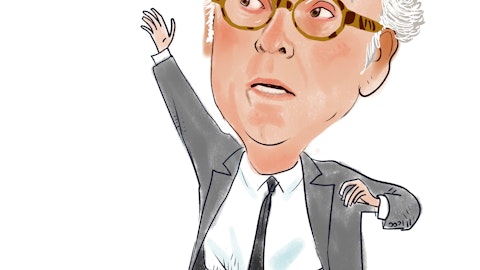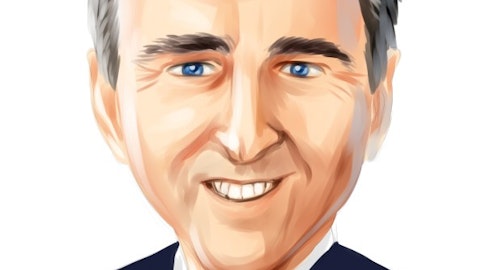Nick Sherwood: Awesome. Thank you for that detail. And then my next question is, what percentage of dentists who adopt your lasers continue to use your lasers as opposed to reverting back to traditional tools? What is that retention rate that you’re seeing?
John Beaver: Yeah, so the most recent surveys we have, have our new doctors who have incorporated this technology in the last six to 12 months. User lasers, about — I think it was about 90% of the doctors use it at least weekly, with a large percentage of that using it daily. And that’s what I see anecdotally in my travels or talking to doctors and so forth. I think that’s further supported by the consumables that we have. We had a blowout year in consumables last year. And what that means is dentists are not only buying the laser, but they’re using it all the time. And to have a 20% increase in consumables, given all the other conditions that we were facing, was pretty remarkable. So I feel really good about doctors using the laser after they buy it.
That may not have been always the case with the laser industry in years past, going back five, 10 years ago, but I think the investments that we’ve made into education and training are really paying off to ensure that the doctors are using the laser after the purchase.
Nick Sherwood: Understood. And then my final question is, what sort of major education programs and events do you have planned for this upcoming or this year?
John Beaver: So, as Jen mentioned, we have, I think, over 500 planned. We have 10 regional/national Waterlase Trial Programs that we have planned this year. We’re at the large events every year, be it Chicago Midwinter, which is completed. We have a big one for us is the California Dental Association coming up in May. We also have Greater New York and a number of regional events as well. For our own events, we have a couple of events internationally that we’re excited about, one coming up in Prague in May, and the other one in Dubai in October. And those are great training events, really drives international revenue for us. And then we have our third annual frenectomy event in Miami coming up in about a month as well where we bring in pediatric dentists and really immerse them in learning how to diagnose, how to perform frenectomies, and also how do you treat the patient, how do you — what is the post-operative care?
And that has been successful the last couple of years, and I’m looking forward to this year as well.
Nick Sherwood: Well, it sounds like you all will be busy, but thank you for answering all my questions and I’ll return to the queue.
John Beaver: Thank you.
Operator: [Operator Instructions] The next question comes from Ed Woo with Ascendiant Capital. Please go ahead.
Ed Woo: Yeah, can you — thanks for taking my question. Can you talk about the competitive environment? Has it changed at all in the past three months?
John Beaver: Not really, Ed. You’ve heard me say before that our chief competition is [indiscernible]. We’re very comfortable when we get head to head against another laser company, given that we are the preeminent dental laser company in the world. We don’t lose a lot of head-to-head matchups with other companies. So I’m less concerned about that and more concerned about us convincing a dentist that their best investment this year is in a laser and not in new office furniture, an integral scanner or something of that nature.
Ed Woo: Great. And you mentioned the macro headwinds. Does that — how much of an impact would that have in your ability to raise prices?
John Beaver: I don’t think it will have any. Our pricing has [tend] (ph) to be pretty, always get this backwards, but elastic I think it is. In other words, the price increases we’ve had really haven’t been met with much pushback. When somebody is convinced they want to and need to incorporate this technology into their practice, they’re ready to go. In other words, $1,000 or $2,000 usually is not going to make a difference. A go, no-go buying decision. So I don’t expect to see much of that. And when we talk about the macro conditions, I think another thing that will help us in 2024 is you look at 2023 with rising interest rates, right? Nobody knew where the top was. I think now most people believe that interest rates have, one, they may not come down significantly in the short term that they no longer are going up or certainly not going up to the extent they have the last 12 to 18 months.
So I think that’s giving some clear visibility on the macro situation to doctors and hopefully will help the buying cycle as well.
Ed Woo: Great. And one last question. What percentage of your sales are financed versus paid in cash?
John Beaver: I’ll answer that with, it depends, and let me explain that. So all of our international sales that we make are paid in cash. In other words, we don’t carry finance on any of that. In the US side, we don’t carry financing either. Most of the Waterlase sales are financed by a doctor’s credit union bank or third party medical equipment financing company, typically over seven, eight years. I mean, it’s a long time because these lasers are robust and won’t last that long. So it’s perfectly — finance companies are perfectly comfortable financing over that period of time. Our diodes, the Epic brand, tend to be more credit card purchases and they, those obviously come in immediately. And our consumables are mainly credit cards as well.
Ed Woo: Great. Well, thank you. And I wish you guys good luck. Thank you.
John Beaver: Thank you, Ed.
Operator: This concludes our question-and-answer session. I would like to turn the conference back over to John Beaver for any closing remarks.



